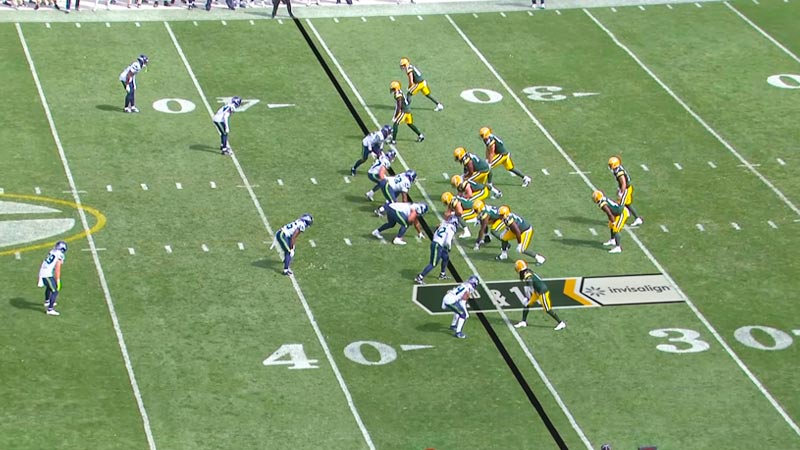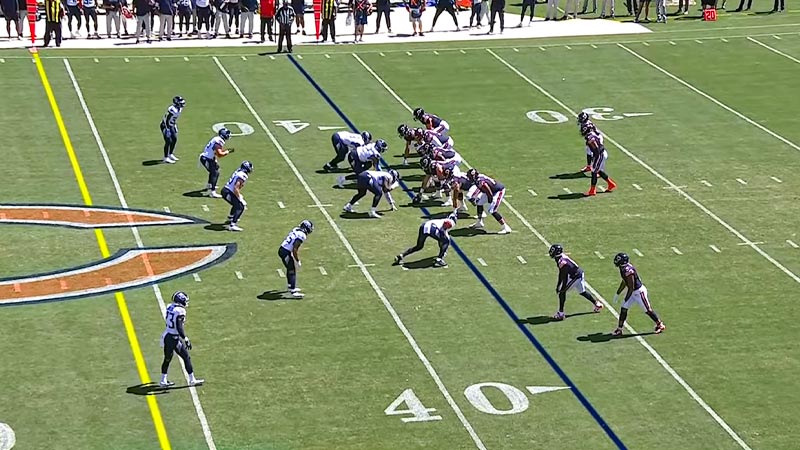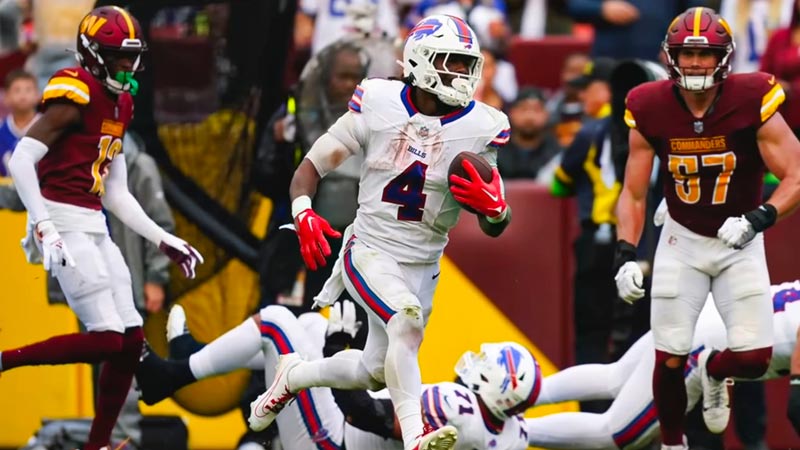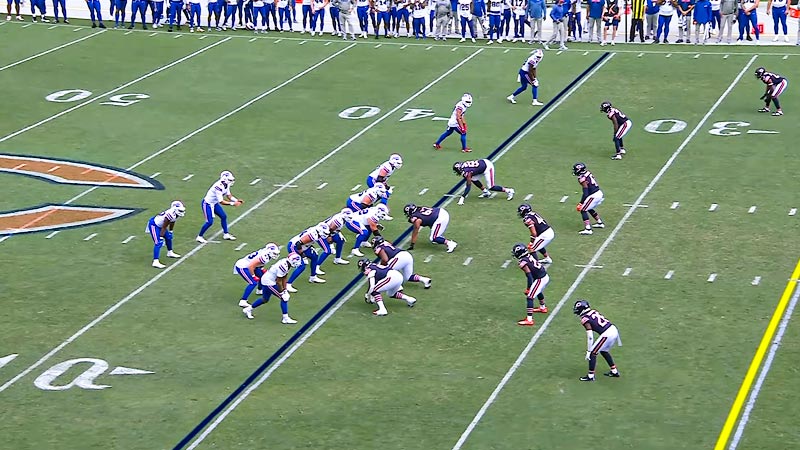In the dynamic world of American football, the defensive end stands as a linchpin in the intricate tapestry of defensive strategies.
This blog post delves into the multifaceted role of the American Football Defensive End, exploring the skills, tactics, and strategic considerations that elevate these athletes to elite status on the gridiron.
From pass-rushing prowess to run-stopping finesse, we unravel the intricacies that make defensive ends indispensable assets to their teams.
Discover the blend of speed, agility, and football intelligence that defines success in this position, and understand how these players disrupt opposing offences to shape the course of a game.
Overview of American Football Defensive Positions
American football defensive positions are crucial to a team’s strategy to prevent the opposing team from scoring.
Each position has specific responsibilities, and players are strategically placed on the field to defend against various offensive plays.
Here is an overview of some vital defensive positions in American football:
Defensive Linemen (DL)
Usually, there are two defensive tackles, and their primary responsibility is to stop the run and rush the quarterback. They line up on the interior of the defensive line, often facing the offensive guards and centre.
There are typically two defensive ends, and their main tasks include containing the run and pressuring the quarterback. They line up outside the defensive line, opposite the offensive tackles.
Linebackers (LB)
Positioned in the middle of the defense, the middle linebacker is often a leader on the field. They are responsible for stopping the run, covering the middle of the field, and sometimes blitzing the quarterback.
There are two outside linebackers, one on each side of the formation. They must be versatile, capable of defending against the run, covering tight ends or receivers, and blitzing the quarterback.
Defensive Backs (DB)
Cornerbacks line up on the edges of the defense, covering wide receivers and preventing them from catching passes. They must be agile, quick, and have substantial coverage skills.
There are two types of safety — free safety (FS) and strong safety (SS). Safeties are the last line of defense, preventing long passes and supporting the run defense.
The free safety often plays a more profound role in coverage, while the strong safety may play closer to the line of scrimmage.
Nickelback and Dimeback
In passing situations, teams may bring additional defensive backs to replace linebackers or linemen. The nickelback typically replaces a linebacker, while the dimeback replaces a second linebacker, providing more coverage against the pass.
Defensive Tackle/End Hybrid (3-4 Defense)
In a 3-4 defensive scheme, players may serve as a hybrid between defensive tackle and end. These players are versatile and can adapt to different defensive responsibilities.
Each defensive position requires a unique skill set, and the combination of these positions forms the defensive unit.
Coaches strategically deploy players based on the offensive formation, down and distance, and the strengths and weaknesses of both teams. Successful defenses often have players who can stop the run, rush the passer, and excel in pass coverage.
What Is Defensive End Football Position?

The defensive end (DE) is critical in American football, primarily disrupting the opposing team’s offensive plays.
Typically stationed at the ends of the defensive line, opposite the offensive tackles, defensive ends are crucial in both run and pass defense.
Their primary responsibilities include pressuring the quarterback, tackling ball carriers, and containing outside runs.
Possessing a combination of speed, strength, and agility, defensive ends must outmanoeuvre offensive linemen to disrupt plays. They play a vital role in sacking the quarterback, forcing turnovers, and defending against sweeps or pitches.
Adaptability is essential as defensive ends must swiftly transition from pursuing the passer to stopping the run based on the offensive situation.
Skills and Attributes of a Successful Defensive End
Successful defensive ends in American football possess diverse skills and attributes, combining physical prowess with strategic insight. Key characteristics include:
Speed and Agility
Defensive ends need quick bursts of speed to get past offensive linemen and pursue quarterbacks or ball carriers. Agility allows them to navigate through traffic and change direction rapidly.
Strength and Power
Physical strength is vital for shedding blockers, stopping the run, and overpowering offensive linemen. The ability to bull-rush and use power moves is crucial for disrupting plays.
Hand Technique
Effective use of hands is essential for shedding blockers and creating separation. Hand placement and various techniques, such as swats and rips, enable defensive ends to gain an advantage over offensive linemen.
Pass Rush Techniques
Successful defensive ends master a repertoire of pass-rushing moves, including speed rushes, spin, and swim moves, to pressure and sack the quarterback.
Tackling Skills
Sound tackling technique is crucial for defensive ends to effectively bring down ball carriers, whether in the open field or tight quarters.
Football IQ
Understanding offensive schemes, recognizing play patterns, and anticipating the opposing team’s strategy contribute to a defensive end’s success. This intelligence allows for effective decision-making in the field.
Discipline and Gap Control
Defensive ends must maintain discipline in their assigned gaps to prevent running backs from finding openings. Maintaining gap integrity is essential for a stout run defence.
Endurance
The position demands a high level of endurance as defensive ends engage in intense physical battles throughout the game. Endurance ensures consistent performance throughout a game.
Combining these skills and attributes enables a defensive end to be a disruptive force on the field, impacting both the run and pass phases of the game.
Defensive End’s Role in Pass Rushing

The defensive end’s role in pass rushing is crucial to a team’s defensive success in American football. Pass rushing involves putting pressure on the opposing quarterback to disrupt or stop passing plays.
Here’s a breakdown of the defensive end’s role in pass rushing:
Speed off the Edge
Defensive ends often utilize their speed and agility to quickly get off the line of scrimmage and around offensive tackles. This burst of speed is essential for reaching the quarterback before a pass can be thrown.
Variety of Moves
Successful pass rushers employ a repertoire of moves to beat offensive linemen. This includes speed rushes, bull rushes, spin moves, and hand techniques to create separation and get to the quarterback.
Hand Placement and Technique
Effective use of hands is crucial for a defensive end. Proper hand placement helps them control the offensive lineman, disengage from blocks, and find a direct path to the quarterback.
Understanding Blocking Schemes
Defensive ends must analyze the opposing team’s blocking schemes to identify weaknesses and exploit gaps in protection.
Recognizing double teams, chip blocks, and sliding protections is critical to overcoming offensive linemen.
Quick Decision-Making
Passing requires quick decision-making. Defensive ends must read the play, react to the offensive line’s movements, and adjust their approach to penetrate the pocket effectively.
Awareness of Down and Distance
Understanding the down and distance situation is critical. In longer-yardage situations, defensive ends may focus more on speed rushes to capitalize on the need for longer-developing passing plays.
Disrupting the Pocket
A successful pass rusher disrupts the quarterback’s comfort in the pocket. This disruption can lead to hurried throws, sacks, or even turnovers. Pressuring the quarterback consistently is a primary objective.
Working in Tandem
Defensive ends often coordinate with other members of the defensive line to execute stunts and twists. This teamwork helps create confusion along the offensive line, opening opportunities for individual success.
Situational Awareness

Understanding the game situation, such as the score and time remaining, influences a defensive end’s pass-rushing strategy.
In certain situations, prioritizing containment and preventing the quarterback from escaping the pocket may be crucial.
Adaptability
Pass rushers must adapt their techniques based on the offensive formations and the tendencies of individual linemen. The ability to adjust during a game is essential for sustained success.
A skilled defensive end can disrupt the timing of the passing game, force turnovers, and significantly impact the outcome of a match by consistently applying effective pass-rushing techniques.
Strategic Considerations of Players in the Defensive End Position
Players in the defensive end position must consider various strategic considerations to contribute to their team’s defensive efforts effectively. Here are critical strategic aspects for defensive ends:
Preventing the Run
While the primary focus is often on pass rushing, defensive ends must be adept at stopping the run. Maintaining gap discipline and setting the edge is crucial for containing running backs.
Pass Rush Techniques
Defensive ends should diversify their pass-rush techniques. This includes developing a repertoire of moves to beat offensive linemen, such as speed rushes, power, and counter moves.
Film Study
Studying game film helps defensive ends identify the tendencies of opposing offensive linemen and quarterbacks. This knowledge allows for more informed decision-making in the field.
Exploiting Weaknesses
Identifying weaknesses in the offensive line or recognizing mismatches is essential. Defensive ends should exploit these vulnerabilities to disrupt plays and pressure the quarterback.
Hand Placement and Disengagement
Effective use of hands is critical for defensive ends. Proper hand placement allows them to control blockers, shed blocks, and disengage to make plays against the run or pass.
Coordination with Teammates
Defensive ends often coordinate with other members of the defensive line. Stunts, twists, and coordinated rushes can create confusion along the offensive line and generate opportunities for sacks.
Situational Awareness
Defensive ends must know the game situation, including the score, time remaining, and down and distance. This awareness influences their approach, especially in critical moments.
Controlling the Pocket
While pass rushing, defensive ends aim to collapse the pocket, limiting the quarterback’s ability to step up and make accurate throws. This disruption is critical to effective pass defense.
Versatility
Being versatile is crucial for defensive ends. They may need to adjust their techniques based on the offensive game plan, whether facing a mobile quarterback or a quick passing attack.
Recognizing Play Action
Defensive ends must distinguish between run and pass plays, especially when play-action fakes are common. Quick recognition prevents being drawn out of position.
By considering these strategic elements, defensive ends can maximize their impact on the game, disrupting the running and passing aspects of the opposing team’s offence.
FAQs
What is the primary role of a defensive end in American football?
Defensive ends play a dual role, excelling in pass rushing and run defense.
Their main objectives include pressuring the quarterback, disrupting passing plays, and containing running backs by setting the edge and maintaining gap discipline.
How do defensive ends contribute to pass defense?
Defensive ends disrupt the passing game by applying pressure on the quarterback.
They utilize various pass-rushing techniques, such as speed rushes and power moves, to collapse the pocket, disturb the quarterback’s timing, and create opportunities for sacks or turnovers.
What skills are essential for a successful defensive end?
Successful defensive ends require speed, agility, strength, and effective hand techniques.
They must possess a diverse pass-rushing repertoire, sound tackling skills, football intelligence, and the ability to adapt to different offensive formations and strategies.
How do defensive ends work in coordination with other defensive players?
Defensive ends often coordinate with teammates on the defensive line, executing stunts, twists, and coordinated rushes to confuse offensive linemen.
This teamwork helps create opportunities for individual success and enhances the overall effectiveness of the pass rush.
Wrapping Up
In the high-stakes arena of American football, the defensive end emerges not only as a guardian of the goal line but as a strategic force reshaping the game’s dynamics.
Their ability to seamlessly transition between disrupting passes and halting runs illustrates the versatility demanded in this pivotal position.
As we conclude this exploration into American Football Defensive Ends, it becomes evident that their impact transcends statistics, embodying the essence of teamwork and tactical brilliance.
With their unique skill sets and strategic insight, these athletes underscore the intricate ballet between offence and defence, proving that the journey to victory on the gridiron is paved by the relentless pursuit of excellence in every defensive end’s pursuit of triumph.







